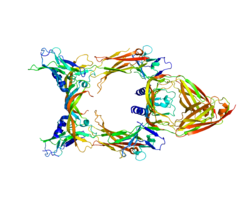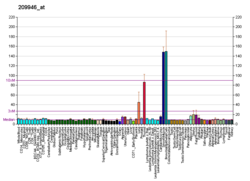Vascular endothelial growth factor C
Vascular endothelial growth factor C (VEGF-C) is a protein that is a member of the platelet-derived growth factor / vascular endothelial growth factor (PDGF/VEGF) family. It is encoded in humans by the VEGFC gene, which is located on chromosome 4q34.
The main function of VEGF-C is in lymphangiogenesis, where it acts on lymphatic endothelial cells (LECs) primarily via its receptor VEGFR-3 promoting survival, growth and migration. It was discovered in 1996 as a ligand for the orphan receptor VEGFR-3. Soon thereafter, it was shown to be a specific growth factor for lymphatic vessels in a variety of models. However, in addition to its effect on lymphatic vessels, it can also promote the growth of blood vessels and regulate their permeability. The effect on blood vessels can be mediated via its primary receptor VEGFR-3 or its secondary receptor VEGFR-2. Apart from vascular targets, VEGF-C is also important for neural development and blood pressure regulation.
...
Wikipedia


